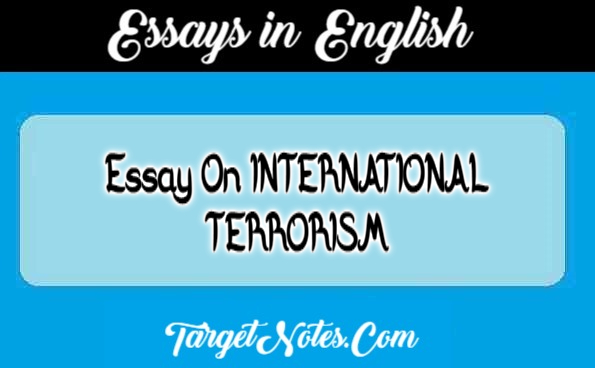
Essay On INTERNATIONAL TERRORISM
Introduction
The biggest threat that the nation-state is facing today, flows out of terrorism which is widespread geographically and diverse ideologically. Modern terrorism thrives on its ability to hit where it hurts the most. While the hallmark of the earlier terrorists was that they wanted a lot of people watching and not a lot of people dead, modern terrorists see death and destruction as an end in itself. Old terrorists sought to change the world, as they were fired by apocalyptic visions. The practitioners of modern terrorism believe the world is beyond redemption. Irish terrorists, the Italian and Japanese Red Brigades, the Baader-Meinhoff gang in Germany, Islamic and Jewish fundamentalists have all sought to spread their ideology by the sword.
‘Terrorists’ machine-gun fire has interrupted the prayers of dozens of worshippers and cut short the journey of bus, rail and air passengers. Dozens of countries are bleeding from terrorism of one hue or another. Terrorists based on South and West Asia have spilled blood in far-off lands-the streets of Buenos Aires, New York, Nairobi, Dar-e-Salaam and Moscow. No one seems to be safe from the hideous ugly death.
Definition
At present Terrorism is defined as violence against innocent citizens to secure political ends. It is the tool used by groups seeking to force a government to yield on political issues. Attacking the citizens is the means by which the population is terrorised. This makes the government look helpless and incompetent. The citizens’ pressure builds up and in due course the government capitulates and seeks to come to terms with the terrorists. The legitimacy of the government is then questioned by the citizens. The political cost of not being able to protect the citizens on the one hand, and the failure to tackle the terrorist threat on the other, is quite heavy.
While Islam has been projected by the fundamentalists as a religion of compassion, justice and equality, the likes of bin Laden and Chechen warlords like Basayev and Khattab have sought to project Islam as an emblem of defiance, intolerance and crude militancy.
Politically based Crime
Crime and politics having become two sides of the same coin, the well-being of the citizen is relegated to a secondary status. In this confused perception of security the terrorist has a ready field to exploit. The relationship between the citizen and the state having snapped, terrorists target the citizens with greater violence and in the least expected places. There is a limit to the security the state can provide on its own. It needs the citizen to help the state with security. The citizen is unwilling to be part of the security chain due to his disillusionment with the state of governance. A military apparatus cannot be the glue which binds the citizen and the state in a security relationship.
Terrorists from Lower Middle Class
The Hijackers are classified as terrorists. It is a different form of warfare. Terrorists use violence to create an atmosphere of fear. They choose soft targets and adopt extreme positions. The typical terrorist would be around 20/25 years. Often, the terrorist is a male but young women too have played a prominent role as we see in the cases of Palestinians and the Tamil Tigers of Sri Lanka. He or she would be single and comes mostly from the lower middle class.
Urban Guerillas
Terrorists have been called urban guerillas because they have adopted the tactics of guerilla warface. Because the word “terrorist” connotes mindless violence. They prefer to describe themselves as “militants”. Public property, political, police officers, diplomats, business executives and other prominent personalities are their targets. Those who take to terrorism are self-conscious and suffer from a sense of injustice.
Objectives of Terrorists
Their objectives are: (a) to publicise the existence of a given group. This explains why a particular group will inform the media about its involvement in a terrorist act immediately after the act. (b) Gain public attention and sympathy for the cause. (c) Gain acceptance of the moral justification of their otherwise inhuman actions,
Visions of Terrorists
The terrorist would be fearless and ruthless because he is fired by the thought that any act, be it killing of innocent civilians or destruction of public property or holy places to achieve the goals set by his group, is justified. He is totally intolerant of any other point of view but its own. The terrorist has a tunnel vision that every other idea is wrong and is ready to die for his cause.
Lack of Collective Action
Cognizance of international terrorism was taken up by the world community as early as in 1934. Since 1960, the focus of the world community has centred on terrorism in Aviation industry as well. In 1963, a ‘Convention for suppression of unlawful seizure of air-craft’ was held at Tokyo, in 1970, another convention was held at the Hague, and again in 1971 another convention was held at Montreal. All those conventions proved ineffective. Even those countries which are already victims of terrorism are not prepared to take any collective action. So the victim country has to protect itself against terrorism. Since India has become vulnerable to terrorism, a separate force on the lines of Border Security Force, needs to be developed to deal with terrorism in all its aspect. This force should be independent and self contained. It should be equipped with modern weapons, transport and communication system. It should be empowered to take decisions and action on its own.
Conclusion
The best way to handle terrorism is not to yield. The terrorist loses interest once he is convinced his method is not going to succeed. He may cause fear and panic but many of his goals would be defeated. The media must stop glamorising the terrorist and tell the public the truth that the terrorist is a criminal.
Vocabulary
Redemption- ransom, Ideology- science of Ideas, Cognizance- knowledge, Convention- a formal assembly, Contain- enclose, Vulnerable- being wounded, Yield- submit, to give in return for, बदले में देना, मान लेना।
IMPORTANT LINK
- आदर्श इतिहास शिक्षक के गुण एंव समाज में भूमिका
- विभिन्न स्तरों पर इतिहास शिक्षण के उद्देश्य प्राथमिक, माध्यमिक तथा उच्चतर माध्यमिक स्तर
- इतिहास शिक्षण के उद्देश्य | माध्यमिक स्तर पर इतिहास शिक्षण के उद्देश्य | इतिहास शिक्षण के व्यवहारात्मक लाभ
- इतिहास शिक्षण में सहसम्बन्ध का क्या अर्थ है ? आप इतिहास शिक्षण का सह-सम्बन्ध अन्य विषयों से किस प्रकार स्थापित करेंगे ?
- इतिहास क्या है ? इतिहास की प्रकृति एवं क्षेत्र
- राष्ट्रीय उच्चतर शिक्षा अभियान के विषय में आप क्या जानते हैं ?
- शिक्षा के वैकल्पिक प्रयोग के सन्दर्भ में एस० एन० डी० टी० की भूमिका
- राष्ट्रीय पाठ्यचर्या की रूपरेखा (एन.सी.एफ.-2005) [National Curriculum Framework (NCF-2005) ]
Disclaimer





